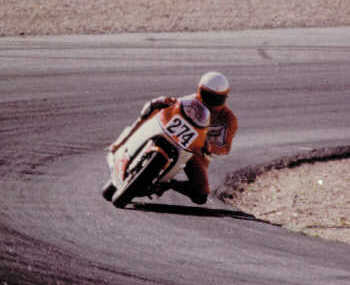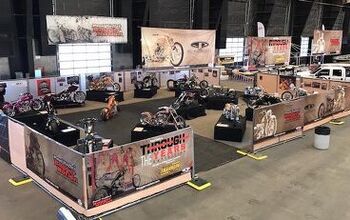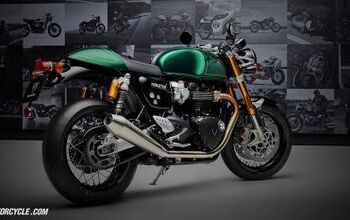THROUGH THE YEARS
Production motorcycles are flawed. If they weren't, there would be little need for the aftermarket industry. Two-strokes, especially, respond well to even the smallest changes, and improving power is much easier - and less expensive - than on a comparable four-stroke motorcycle.
This bike needs a serious dose of Slim-Fast!
And the RZ500 is no exception to this. Having owned one for over ten years has exposed me to its various weak points. Luckily there are few: Yamaha's big two-stroke is a very impressive motorcycle right out of the box. The steel frame is quite rigid (the Japan-only RZV's aluminum frame is even better), and the engine cranks out class-leading power. But the 500's biggest downfall in stock form is its weight.
The heaviest offender is the exhaust system: The quartet of expansion chambers weigh a ton!
The lower pipes aren't that bad, but the upper pipes are anchors, and their heft is carried high in the frame. Not Good. Remember, this bike was cloned after King Kenny's GP-winning YZR! But in order to achieve the good balance Steve was talking about, the RZ must lose weight. They're constructed of double-wall, heavy-gauge steel, and are shrouded in various steel heat shields to help keep the temperature of the rider's bum from reaching the red zone (which, on a hot day, will still get slow-roasted). Although the stock pipes deliver good, streetable power up to and beyond redline, a good set of after-market chambers will improve horsepower, throttle response, and they will save 25 or 30 pounds.
This modification alone is worth the price of admission, though on a four-cylinder two-stroke, that price can be quite high. Four hand built expansion chambers don't come cheap. But we've found the power gains and weight savings offer the best "bang for the buck." Several after-market designs have been offered through the years. Early pipe builders for the RZ included Erik Buell and Stuart Toomey. Of course these two guys need no introduction.
Although Buell is now commonly associated with his trick sporting Harley's, we can't forget his roots are in two-strokes, having campaigned a TZ750 on the national circuit in the late 70's. And Toomey's two-stroke tuning expertise has been utilized in many successful racing programs. Both of their pipe offerings were short lived, and limited in production, but were among the best designs ever sold for the RZ. Current pipe builders offering production designs include TC Exhaust/Lance Gamma (California), Nikon Racing (England), and famous European pipe designers, Jolly Moto (Italy). All of these pipe designs have been thoroughly tested, give true power gains, and really improve the portly RZ's power-to-weight ratio. But the RZ500 has another flaw that, when corrected, compliments the addition of after-market pipes and yields even more power.
The RZ's engine, at first glance, is rather intimidating. The motor is buried in a maze of cables, airboxes, and carburetors. Strip away all this baggage, though, and what you have is a basic water-cooled two-stroke. Think of it as two engines mounted to a common crankcase. Simple, but because of the location of some of the RZ's coolant pipes and power-valve hardware in the V of the motor, there was little room left for large, multi-pedal reed cages. As a result, Yamaha fitted the RZ with reed blocks straight off the old RD400. These reed blocks are very restrictive, and to balance the rest of the intake system to these reeds, Yamaha installed small 26mm Mikuni carburetors. Similarly, the cylinder's exhaust ports were similarly down-sized to make the package complete. This engine has the capability to pump a lot of air, but you have to make more air available to the engine first.
So get out the die-grinder!
There's no room for larger reed blocks off another bike, but the stock blocks can be opened up to flow substantially more air. Top them off with a good set of fiberglass or carbon-fiber reeds, slap on a set of 28mm TMX series Mikuni flatslide carburetors, port the exhaust area to match, and now you have an engine that, with the aftermarket pipes, will make v 100-plus horsepower and is quite reliable to boot.
I say reliable because when the 500 first appeared, Yamaha's engineers stated the V-four motor was mildly stressed in stock form. Read this to mean "over-built" and "under-tuned." The twin cranks are very stout units, and crank failure has proven to be extremely rare.
Standard two-stroke practice of truing and welding the cranks is all that's necessary. The RZ also has very a conservative compression ratio (approx. 6.6 to 1). Milling the heads 1 - 2 mm's is highly recommended when performing the above outlined intake modifications. In the hands of a good two-stroke tuner, it is entirely possible to achieve upwards of 120 HP from the little 500. I love those power wheelies!
Another common mod is to replace the RZ's 16 inch front and 18 inch rear wheels with more modern 17 inch units from an FZR600 or FZR1000.
Of course, you cannot forget the chassis. Remember, the RZ is a rather slow handler in original form. Most of the suspension components have become rather dated by today's standards. But you see, Yamaha has gained a reputation for being what I call a "parts bin company." Several components from other more recent Yamaha sport bikes are easily adapted to the 500 to give it a more updated look and feel. The RZV's aluminum frame, although rare and hard to find, is an excellent modification to a steel-framed RZ or RD-LC. I did this to one of my RZ's, and immediately noticed improved handling. And it shaved a whopping 11 pounds off the RZ's weight!
Another common mod is to replace the RZ's 16 inch front and 18 inch rear wheels with more modern 17 inch units from an FZR600 or FZR1000. In fact, the whole front ends from these bikes slip easily into the RZ's frame. This modification not only allows the use of today's sticky radial tires, but lets you mount massive front brake rotors and multi-piston calipers.
Rear shock offerings for the RZ come from both Fox and Ohlins. These multi-adjustable, remote-reservoir units are another "must do" modification for the RZ, as the stock shock is simply junk. Handling can be tremendously improved over the slow-steering stock set-up with the addition of wider 17 inch wheels, radial tires, Progressive Suspension springs, braided stainless steel brake lines, and a Fox or Ohlins shock. If keeping the stock forks, you've got to disconnect the anti-dive valve. The vastly improved feel at the brake lever is well worth the trade-off of loosing the wimpy anti-dive circuitry.
So now the overweight, high-effort, out-dated RZ500 has been transformed into the lean, modern, powerful two-stroke GP replica it was meant to be. Want to feel like Kenny Roberts? Tweak an RZ500. The only thing missing will be the factory contract. Where are my leathers, anyway?
More by Tom Fortune






























Comments
Join the conversation